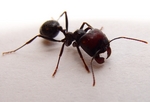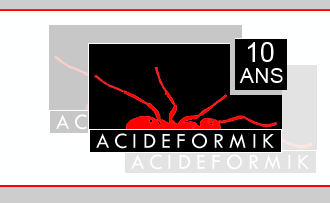Bienvenue invité ( Connexion | Inscription )
  |
 Monday 16 January 2012 à 11:13 Monday 16 January 2012 à 11:13
Message
#1
|
|
 Ouvrière Groupe: Membres Messages: 407 Inscrit: 21/01/2009 Lieu : Dijon Membre No.: 2 918 |
Bonjour,
Vous le savez tous, les Temnothorax sp vivent la plupart du temps dans des glands, galles ou autres coquilles d'escargots, comment font-elles alors pour survivre à l'hiver ? J'observe beaucoup de colonies dans des noisettes creuses dans mon jardin, nul doute que l'interieur doit geler en hiver. De là j'ai deux questions: comment arrivent-elles à vivre malgré tout ? Et cette espèce demande-t-elle du coup une pause particulièrement froide par rapport aux autres espèces ? Merci -------------------- |
|
|
|
 Monday 16 January 2012 à 11:24 Monday 16 January 2012 à 11:24
Message
#2
|
|
 Gyne Très Mégère Groupe: Administrateurs Messages: 9 763 Inscrit: 02/05/2007 Lieu : Nord Membre No.: 1 369 |
C'est une bonne question. Je pense qu'Hugo pourra répondre.
Il a dit (ou m'a dit) que le couvain doit diapauser pour nymphoser (et c'est pour ça que c'est lent à se développer ces colos). -------------------- |
|
|
|
 Monday 16 January 2012 à 15:19 Monday 16 January 2012 à 15:19
Message
#3
|
|
 (●ʘ╻ʘ●) ~ ♥ Groupe: Modérateurs Messages: 6 121 Inscrit: 17/08/2005 Lieu : Australie Membre No.: 284 |
Non anglophones
CITATION Il a dit (ou m'a dit) que le couvain doit diapauser pour nymphoser (et c'est pour ça que c'est lent à se développer ces colos). C'est possible que j'ai dit le contraire : c'est lent à développer, donc les larves passent souvent (toujours ?) par une diapause. Pour les larves Kipyatkov, V.E. & Lopatina, E.B., 2007. Seasonal cycles and strategies in ants: Structure, diversity and adaptive traits CITATION . Most temperate & all boreal climate ants, however, are true heterodynamic, i.e. they possess real winter diapause (prospective dormancy) in their annual cycle. The strategy of prolonged brood-rearing has 2 evident advantages in cold climates. First, the larvae can be reared from early spring up to late autumn, thus utilizing the entire growing season. Second, the quantity of rapid brood can be changed to adapt to long-term & short-term climatic variations and to the duration of the warm season. Two structural types of seasonal cycles have been distinguished among species with prolonged brood-rearing. In Aphaenogaster type, the larvae enter diapause at the end of summer, but the queens have no diapause & do not cease laying until the late autumn. Therefore, not only diapause larvae, but also eggs & young larvae overwinter and survive, at least partially, during the winter. These species are apparently restricted to the subtropics & the southernmost regions of the temperate zone. Among them, there are all previously studied species of Aphaenogaster, Messor, Monomorium, Polyrhachis, Tapinoma, & Temnothorax. Most species with prolonged brood-rearing belong to Myrmica structural type. They all have winter diapause both in larvae & adults & overwinter without eggs, but only with diapause larvae. The larval stages at which diapause can ensue are extremely variable among ants. Buschinger, A, TA Linksvayer. 2004. Novel blend of life history traits in an inquiline ant, Temnothorax minutissimus, with description of the male (Hymenoptera: Formicidae). Myrmecological News 6: 67-76. CITATION As far as is known, sexuals in independent Temnothorax species develop from hibernated larvae, i.e. as slow brood Dornhaus,Franks, 2006. Colony size affects collective decision-making in the ant Temnothorax albipennis, Insectes Sociaux CITATION In this ant species, 9 months is less than the generation time of workers (larval development time is 1–2 years). En ce qui concerne la survie en hiver M. Herbers, J. and A. Johnson, C. (2007), Social structure and winter survival in acorn ants. Oikos, CITATION Why do these ants remain above ground during the cold months? The answer may lie in their nomadic habits and dependence on pre-formed plant cavities. Cavity-nesters form the majority of all species living in the litter in eastern North American forests (Herbers 1989) and competition for these nests sites can be strong (Herbers 1986b, Herbers and Banschbach 1995, Foitzik and Heinze 1998, DeHeer and Herbers 2004). Furthermore, Temnothorax species are vulnerable to attacks from social parasites (Foitzik and Herbers 2001, Brandt and Foitzik 2004, Foitzik et al. 2004), which places a premium on rapid mobilization for colony emigration. Extensive movement between nest sites in the summer (Herbers 1986b, Herbers and Tucker 1986) is apparently also accompanied by similar nomadic behavior during the cold months. Our understanding of the forces driving spontaneous colony movement is rudimentary (Banschbach and Herbers 1999, Dornhaus et al. 2004, Backus et al. 2006), and movement is important enough for T. curvispinosus that between 20–35% relocate during cold months when other ants are safely belowground. Possessing a good nest site in early spring when larger-bodied competitors surface may be the only strategy that assures acorn ants a domicile the following summer (Herbers 1989).
Staying aboveground presents physiological challenges, and insects have evolved multiple mechanisms to survive low temperatures (Hallman and Denlinger 1998). Some are freeze-tolerant, i.e. able to withstand whole-body freezing; by contrast, freeze-intolerant insects must prevent internal ice nucleation (Graether and Sykes 2004). Aside from the fire ant Solenopsis invicta (Quarles et al. 2005), little is known about the physiological mechanisms by which ants survive freezing temperatures. Although we do not know how T. curvispinosus manages during the cold months, the high rate of movement during brief warm spells in winter indicates that they neither freeze solid nor diapause. Rather, we suspect a secretion of glycerol or similar antifreeze compounds into the hemolymph allows T. curvispinosus to lower their freezing points (Heinze 1992) and retain the ability to become active when temperatures rise. |
|
|
|
 Monday 16 January 2012 à 15:26 Monday 16 January 2012 à 15:26
Message
#4
|
|
 Gyne Très Mégère Groupe: Administrateurs Messages: 9 763 Inscrit: 02/05/2007 Lieu : Nord Membre No.: 1 369 |
Merci Hugo
-------------------- |
|
|
|
 Monday 16 January 2012 à 18:47 Monday 16 January 2012 à 18:47
Message
#5
|
|
 Ouvrière Groupe: Membres Messages: 407 Inscrit: 21/01/2009 Lieu : Dijon Membre No.: 2 918 |
Je te remercie pour ces précisions, voilà qui me donne des éléments de réponse pour l'hivernage de ma jeune colonie de Temnothorax sp
-------------------- |
|
|
|
  |
1 utilisateur(s) sur ce sujet (1 invité(s) et 0 utilisateur(s) anonyme(s))
0 membre(s):
Partagez ce sujet sur un forum (bbcode):
Partagez ce sujet sur un site web ou un blog (html):
| Version bas débit |












